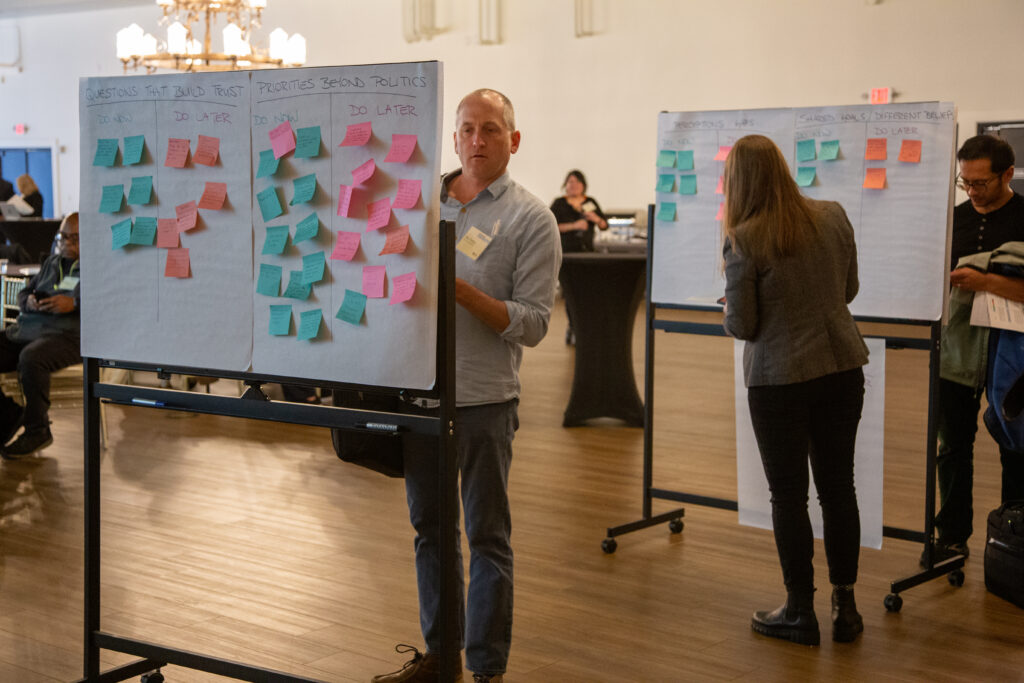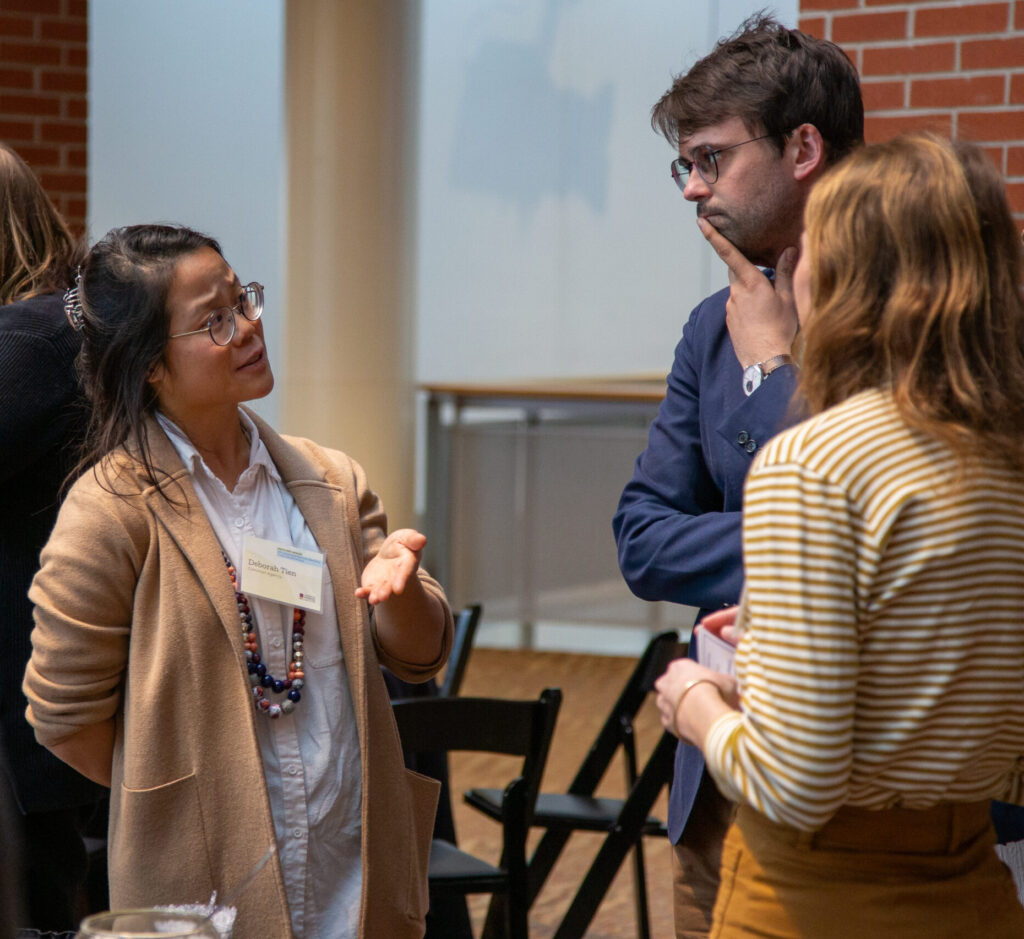Journalism is essential to creating the civic culture that many civil society leaders and philanthropists seek to foster — and that researchers desire to understand or improve.
At its best, an independent local press surfaces common facts we need for our shared reality. It holds powerful people and institutions accountable, those that affect taxes and rents, the water we drink and children’s education and future. It elevates the individuals and groups working to address problems we see daily — and the communal experiences, such as the arts, that take us beyond them. It can model and equip residents for, and even facilitate, conversations on all these fronts, including when they’re challenging and across lines of difference.
The many functions of journalism matter nationally, too. But we feel deeply and daily when those functions deal with our neighbors. We know we need to bridge differences with the people in our neighborhoods.
As we consider how to chart paths forward after the November 2024 elections, local media’s opportunity to convene must be part of the conversation.
Our API Local News Summits offer one window into the kinds of work in “bridging across difference” and depolarization efforts that interest local news leaders. By their design, they also offer insights into how researchers in these spaces may think differently about journalism’s connection to their work.
To support the work of civil society, philanthropy and research, we are sharing what we’ve learned in terms of what ideas have resonated.
Here are some of the calls to action that sparked interest from news leaders over several recent API Local News Summits:
- Reach beyond the politically involved. News leaders are already discussing how to counter news avoidance, and a great deal of it occurs around political news. Experts in polarization and bridging can add consideration around who is being served by that information. In our summits, post-event surveys show many people latched onto University of Michigan Prof. Yanna Krupnikov’s work on “The Other Divide.”From one participant: “I couldn’t stop thinking that I was part of a very strange 20% of the population that cared about politics, and I needed to reach the 80%.” Throughout recent summits, many participants noted conversations about centering issues instead of politics in news coverage and using action and agency ”as an ‘antidote’ to combatting disengagement.”
- Elevate identities and shared experiences beyond politics. Local media are eager to find ways to stand out from national news and information sources and to serve their communities in authentic ways. Several were drawn to ideas in psychology and survey research, such as from the nonprofit research group More in Common, about collective identities that don’t lean on politics.Said one participant: “I absolutely loved to hear from people outside journalism about how we can upskill by learning more about just humans and how humans work and think and behave.” Leveraging nostalgia was one uniting theme that many news leaders — writing the “first draft of history” themselves — wanted to explore.

News leaders post takeaways from small groups led by non-news experts at our API Local News Summit on Elections, Trust and Democracy in Akron, Ohio.
- Design thoughtful community engagement structures. As more news organizations embrace the role of convener, news leaders are looking for the right ways to set up in-person and online engagement for quality discourse or connection. Many civil society organizations have meeting structures they believe work well, and some have research to affirm them; leaders gravitated toward structures, prompts and even specific language that is tested and tried. For example, one participant recalled a “starting point” question Braver Angels would ask a focus group of Michigan voters. Others expressed interest in processes from the world of public deliberation.
- Develop skills to convene and facilitate. Productive in-person engagement requires more than a tested script. Because it’s real life, conversations can evolve in unpredictable ways, including ones with tense moments and conflict. News leaders took an interest in individual convening skills and how to handle conflict in real time — skills that help them listen and bridge on the fly. The “listening tips” API shared in summits were well received (and supported by research), but participants wanted more time to practice them.
Here are some observations from non-news experts following their interaction with news leaders:
- The innovation of local media was out of sight. While the local news landscape is uneven across the country, only some of our non-news experts knew the extent of the bright spots. This is especially true for in-person convening.
“What really stood out to me was the amount of community engagement that was happening in some of these media markets throughout the country,” said Tami Pyfer, co-creator of the Dignity Index, and who previously interacted with local and state press as a city councilperson and state school board member for many years. “I think the overarching narrative that I hear is that local media is dying,” said Deborah Tien, founding steward of Common Agency, who added that people in newsrooms she saw were “hopeful” and “open to exploring different ideas.” There was “much more focus on two-way communication than I had expected,” said another non-news expert.

Deborah Tien, founding steward of Common Agency, talks between sessions to news leaders from Kentucky and Texas.
- The care and thoughtfulness of local journalists were often hidden. Several non-news experts described how much they saw journalists cared about their craft — and their community.
Being a part of conversations with journalists “humanized them in a very positive way,” said Steve Saltwick, a senior fellow at Braver Angels, who described how journalists he spoke to very much wanted to be accurate and fair. Said Krupnikov, a researcher noted above: “I think academics have many criticisms for journalists, and it was really fruitful to hear that [journalists are] cognizant of these kinds of things [academics often note], and trying to address them.” Kate Carney, chief of staff at More in Common, spoke about local news as an anchor institution, with care as a visible driver. “Yes, they were there to provide news and trustworthy coverage and represent voices, but it was very much driven by that ‘we love our community’ piece.”
- The resource and pressure challenges were out of sight. Researchers and non-news experts who spoke admirably about the news leaders also spoke empathetically about their real challenges.
“There’s sometimes less consideration [from researchers] for the breadth and scope of challenges that [journalists] face,” said Krupnikov, pointing to a range of resource challenges that came up in daily tasks of small teams, not to mention other community pressures in publishing journalism. “These guys are at the mercy of a terrible business model, and they’re trying to do their craft,” said Saltwick. Some noted trying to adjust the presentation of their findings for busy journalists based on pressures they heard.
- More research may have applicability locally, not just nationally. Researchers and non-news experts noted many surprising intersections with their work and specifically the challenges facing local news.
“I tend to think about [my work] in terms of impact on people’s global or national attitudes,” said Andrew Abeyta, a Rutgers University psychologist who studies nostalgia. “…[The summit] opened my eyes to how applicable the research is to what some would consider smaller local problems as opposed to big national problems.” Said Pyfer: “It made me want to revisit how we engage journalists [with our process] because of this large amount of community engagement that was happening in local media.”

Social psychologist Andrew Abeyta talks with participants at our API Local News Summit on Rural Journalism, Community and Sustainability in Tulsa, Oklahoma.
- Researchers can learn from news leaders — especially their innovations in community engagement. Several non-news experts talked about how the strategies discussed could help their work, too, including as more academics are pushed to share their work with broader audiences or to create community engagement projects for classes they teach.
Reflected Abeyta: “How can we create opportunities to interact, to be more front-facing with the community, to share the research and to share our knowledge work with local partners?” Another noted the meeting was one of “kindred spirits.”
- Improving the future of news and information is a shared challenge. Many people found common cause with the news leaders or articulated how the press mattered for their vision.
Said Danielle Rugoff, who attended as head of movement activation and partnerships with the nonprofit Starts With Us: “It’s forced me both to enter every conversation and to proactively discuss and explore the various ways we are all responsible for fixing and fortifying our news and media ecosystem.” Rugoff, now founder of Purple Lexicon, and others noted wanting to join others’ small groups to enlarge the conversation about research and civil society helping media. Several noted having a meal together and meeting each other for the first time.
These calls to action and observations suggest where to direct programs and research to fit news leaders’ needs and interests. They also point to ways to build fruitful exchanges between news leaders and researchers, and where to look for impact over time.
This project was made possible through the support of a grant from Templeton World Charity Foundation (funder DOI 501100011730) to better understand how local news leaders and researchers can learn from the other to improve local journalism and limit polarization in their communities (TWCF-2023-32603). The opinions expressed in this report and its excerpt are those of the organizer(s) and do not necessarily reflect the views of Templeton World Charity Foundation, Inc.
Share with your network
- A community of collaboration: How journalists and non-news experts can work together better
- Exchanges between researchers and journalists can go beyond interviews. They can also improve how journalism serves communities.
- The landscape of how news leaders and researchers learn from one another
- Five ‘bright spots’ on bridging across difference + journalism
- How API Local News Summits help news leaders and non-news experts collaborate on solutions
- What’s striking news leaders about listening in a polarized world; what’s striking researchers
- Recommendations to enhance how news leaders and non-news experts inform each other’s work
- Acknowledgements


